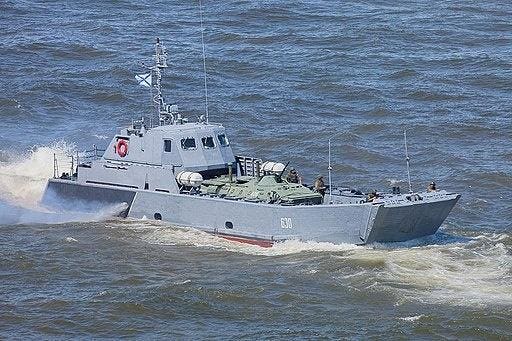Ukraine’s explosives-laden drone boats have struck again—damaging if not sinking a pair of Russian landing craft in western Crimea overnight on Thursday.
It’s the latest blow in Ukraine’s ongoing campaign targeting the Russian Black Sea Fleet. And its aim is clear: to render it difficult for the Kremlin to resupply occupied Crimea and its forces in southern Kherson Oblast.
Slow, ungainly landing craft might be the least sexy of all naval vessels. But in a grinding land campaign adjacent to water, they also might be among the most important vessels.
Think of the drone assaults on landing craft as the naval phase of Ukraine’s Kherson counteroffensive. A counteroffensive that is expanding and accelerating as Russian logistics in southern Ukraine fray.
A video the Ukrainian intel agency posted online depicts a drone boat speeding toward two Black Sea Fleet landing craft in the port of Chornomors’ke on the Tarkhankut Peninsula, 75 miles south of Kherson city.
The Ukrainians initially identified the craft as Serna-class vessels, but observers pointed out that one of the vessels might be an Ondatra. An 84-foot Serna can haul 45 tons of cargo 600 miles. An older, 80-foot Ondatra hauls 50 tons 330 miles.
“Crew and loaded armored vehicles, including BTR-82s, were on the ships” when the drones struck, the intel agency claimed.
It was the second Ukrainian strike on the Black Sea Fleet in less than a week. On Saturday, Ukrainian air force Sukhoi Su-24 bombers launched at least three cruise missiles—British-made Storm Shadows or French-made SCALPs—at the Black Sea Fleet missile corvette Askold, pierside in Kerch on the eastern edge of Crimea.
Imagery released by the Ukrainian government strongly indicates the missiles badly damaged the 220-foot Askold, one of the newest warships in the increasingly battered Black Sea Fleet.
“Confirmed,” Kyiv’s strategic communications directorate stated. “The Russian missile carrier Askold—the newest ship of the Karakurt project with ‘stealth’ technology—was damaged.”
“How was your weekend?” the Ukrainian air force quipped in a social-media post that includes a photo of a SCALP missile.
Askold was just the most recent naval victim of Ukraine’s missile-armed bombers. A Ukrainian missile strike on the port of Sevastopol, in western Crimea, struck a submarine and a landing ship in their drydock on Sept. 13.
In 22 months of hard fighting with an enemy that has no major warships, the Black Sea Fleet has lost at least one cruiser, a corvette, three amphibious ships, a submarine and a supply ship as well as several patrol boats and landing craft—and now potentially the Serna and Ondatra.
A dozen or so surviving missile frigates, corvettes and anti-submarine patrol boats possess the majority of the Black Sea Fleet’s remaining surface firepower—and 10 or so landing craft represent its surviving tactical logistics capacity.
But these vessels must take extreme care to avoid attacks by Ukrainian missiles, rockets, unmanned aerial vehicles, robot boats and saboteurs. The anti-ship threat, from a Ukrainian navy that no longer possesses a single large surface combatant, is complicating Russian logistics across the southern front of Russia’s 22-month wider war on Ukraine.
That’s because the Russians increasingly depend on ships and boats to shuttle supplies between Russia and Crimea, and between Crimea and southern Kherson Oblast.
Overland logistics normally would be safer and more efficient, but the Ukrainians repeatedly have struck at the Kerch Bridge connecting Russia to Crimea. And summer advances by Ukrainian brigades in Zaporizhzhia Oblast, just east of Kherson, put roads and railways in the Russian-occupied south within range of Ukraine’s rocket-artillery.
“With Russia’s land bridge disrupted or closed by Ukrainian indirect fire or even its threat, Crimea would be solely supplied by the Kerch Bridge or by sea,” explained Jan Kallberg, a non-resident senior fellow with the Center for European Policy Analysis in Washington, D.C.
“At that point, the Kremlin would have to make ugly choices—either the Crimean population will suffer significant shortages during the upcoming winter, or the army will go short,” Kallberg added.
It’s apparent the army already is going short. Three weeks ago, the Ukrainian marine corps crossed the Dnipro River into Russian-held southern Kherson—and, since then, only has expanded and reinforced its bridgehead.
Landing in squads and platoons, with only light armor for fire-support and small drones and helicopters for aerial cover, the marines should have been vulnerable to a Russian mechanized counterattack.
But the Russians never managed to organize a major assault on the Dnipro bridgehead. Effective Ukrainian electronic-warfare isn’t the only reason. The Russians also are low on ammunition and fuel. The Russian army’s 205th Brigade, holding positions along the Dnipro, was reporting it had “zero supplies” as recently as August.
One convoy, bridge and landing craft at a time, the Ukrainian armed forces are squeezing Russian logistics in southern Ukraine. With each squeeze, Russian troops in the south get weaker. And the Ukrainian troops attacking them get stronger in comparison.
Read the full article here





